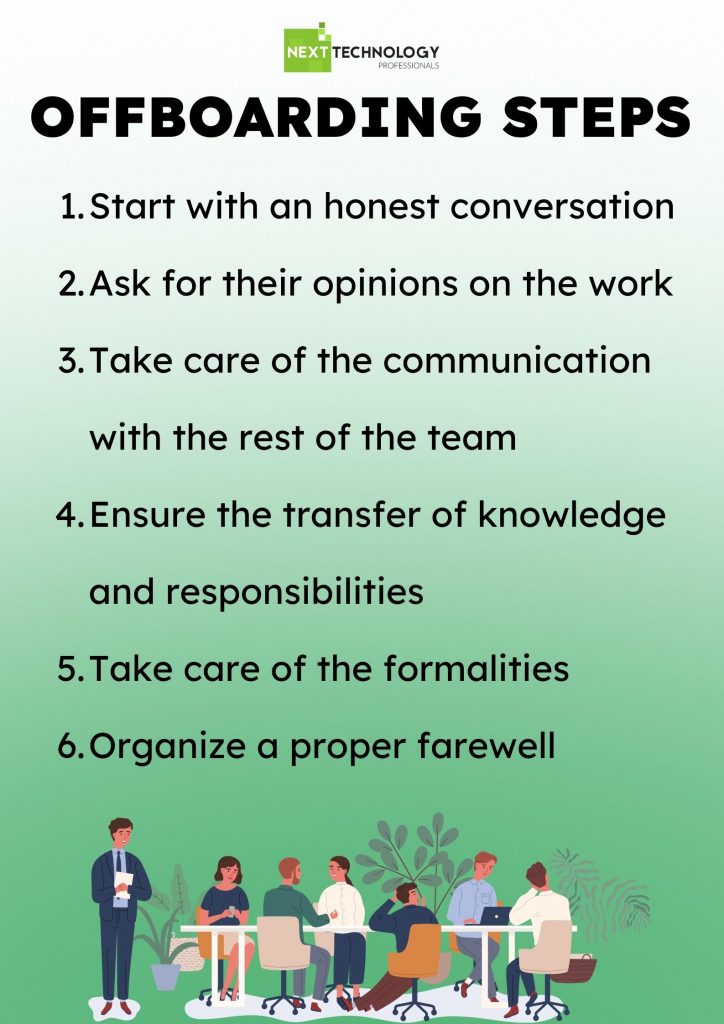In today’s market, employees change jobs more and more often. Candidates are looking for a profession that will give them satisfaction. They quickly verify the promises made by the company for which they work and are much less reluctant to leave it than even 5-10 years ago. For employers, it is associated with a greater expenditure of time and on recruitment and employer branding activities, and a more frequent need to organize the offboarding process.
Employees leave employers for various reasons. It could be:
- for non-professional reasons, e.g. due to the necessity to relocate or private problems that force him/her to undertake major changes in his/her life;
- retirement;
- for professional reasons, resulting from the employee’s dissatisfaction with work in the company or a specific team, or with a proposal for a new job, in which the conditions exceed the benefits offered by the current company;
- giving notice to an employee whose work the company’s representatives are not satisfied with.
Whatever the reason for an employee leaving, saying goodbye is always difficult and stressful. According to the stress scale of Thomas Holmes and Richard Rahe, changes related to working life are among the most stressful events in human life. Dismissal ranks 8th on the list of the strongest stressors, and a major change in work ranks 15th. A strong emotional reaction may also be caused by a change in the work environment (rank 18) and a change in its conditions (rank 31).
How to properly carry out offboarding to make this process as little stressful as possible for both parties?
First of all, let’s take care of maintaining positive relations with employees and offer our help in coping with the change. And after offboarding is over, let’s stay in touch with former employees.
Currently, the return of employees to the organization is nothing surprising. Former employees can also recommend work in the company to their friends and promote the brand in their network of contacts. So let’s leave a good impression.

Let’s start with an honest conversation
Regardless of which party is the initiator of the separation from the employee, three people should participate in the interview: the employee who leaves the company, his supervisor and a representative of the HR department. The basis of the dismissal conversation is honesty. The employee should receive all necessary information on the next steps and reasons for the situation (if the reason for the departure is dismissal) and reliable feedback on his/her work in the company. We should not avoid raising difficult topics and asking questions in order to better understand the situation, while maintaining orientation towards the employee’s needs and the difficult emotions that may accompany the dialogue.
Image source: https://tallyfy.com/employee-offboarding/
Let’s ask for their opinions on the work
One of the forms of conversation with the departing employee is an exit interview, i.e. an interview during which we can gather his/her opinions about the company and what they liked while working with us, and what they assessed negatively. The insights of the person saying goodbye to the company are often a huge source of knowledge for HR and EB representatives. Such employee usually does not feel pressure or fear related to commenting on the behavior of people working in the company. Thanks to this, they can honestly share their thoughts. The conversation is therefore based on constructive feedback from the employee on the functioning of the company, both in terms of HR processes and the atmosphere and problems in a specific team, and is a starting point for improving activities in this area.
For the best results, it is worth ensuring that the interviews take place in a pleasant atmosphere, encouraging honest statements. Ideally, they should be carried out by a representative of the HR department, who was not in close cooperation with the person leaving the company. During the interview, you can also raise nice topics, such as positive memories from work, and use this opportunity to appreciate the employee’s contribution to the development and success of the team and the entire company.
Let’s take care of the communication with the rest of the team
The departing employee participated in the life of the company, he co-created many projects with other employees and took part in various initiatives. People remaining in the company should be informed about the departure and the planned continuation of the projects. In this way, they will be able to refine the action plans and reorganize the work, minimizing the risk of delays.
Additionally, we must pay attention to the issue of the motivation of employees remaining in the organization. The team should find out the real reasons for leaving the company. It is much better to rely on reliable, transparent communication than to let gossip spread, which can increase the feeling of insecurity or demotivation of employees. Determine who will pass the information on to your team. Whether the leaving employee will want to do so, the team manager or whether it should be done during the meeting of the whole group.
Ensure the transfer of knowledge and responsibilities
Offboarding should not involve a loss of knowledge in the company. If possible, it is best if the person leaving the company trains someone to take their place and communicates all the information and skills on their own. If such a solution is not possible, it is worth asking to write down instructions and tips for employees who are to take over the duties. It is a good idea to put the information on a shared drive so that each team member can use it when needed.
Let’s take care of the formalities
We also cannot forget about formal obligations. When employees leave, it is worth preparing a list of important activities that we must take care of before the final end of the cooperation. The list must include, among others:
- agreed notice period,
- the number of vacation days and how to collect them,
- deadline for the handover of duties,
- the names of the people taking over the duties,
- deadline for handing over of work equipment.
Organize a proper farewell
The day when an employee says goodbye to the organization can be a difficult day. Regardless of the reasons for terminating the contract, it is worth making sure that the farewell is in a positive atmosphere and leaves pleasant memories, both in the mind of the departing employee and the rest of the team. We can organize a modest farewell party during which the employee will be able to say goodbye to colleagues. It is also worth thinking about buying a gift that will be a memento of the time spent in the company. The way we say goodbye to employees says a lot about the company’s organizational culture.
If you’re looking for a new IT specialist to join your company, contact us. We can find a reliable person that will stay within your company for a long period of time.




